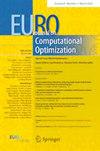Efficient use of optimality conditions in Interval Branch and Bound methods
IF 1.7
Q2 OPERATIONS RESEARCH & MANAGEMENT SCIENCE
引用次数: 0
Abstract
The Interval Branch and Bound (IBB) method is a widely used approach for solving nonlinear programming problems where a rigorous solution is required. The method uses Interval Arithmetic (IA) to handle rounding errors in calculations. In the literature, a wide range of variations of IBB exists. However, few IBB implementations use the Karush-Kuhn-Tucker (KKT) or the Fritz-John (FJ) optimality conditions to eliminate non-optimal boxes. The application of the FJ conditions implies to solve a system of interval linear equations, which is often challenging due to overestimation of the boxes. This study focuses on the geometric perspective of the FJ optimality conditions. A preliminary test is introduced, namely the Geometrical Test, which tries to decide when the optimality conditions cannot hold or whether it is convenient to compute the Fritz-John Test. Furthermore, a test case generator is presented that transforms unconstrained problems into constrained test cases by setting a given number of active and inactive constraints at a global optimizer. The efficiency of the Geometrical Test was considered through computational experiments on the generated benchmark. Six variations of the IBB were compared, with or without the FJ condition system and Geometrical Test. The best methods for solving the 272 generated test cases use the designed Geometrical Test with the Lagrange estimator and the Newton step on the normalized interval FJ conditions in most cases.
区间分支和定界方法中最优性条件的有效利用
区间分支定界法(IBB)是求解非线性规划问题的一种广泛使用的方法。该方法使用区间算术(IA)来处理计算中的舍入错误。在文献中,IBB存在着广泛的变异。然而,很少有IBB实现使用Karush-Kuhn-Tucker (KKT)或Fritz-John (FJ)最优性条件来消除非最优框。FJ条件的应用意味着求解一个区间线性方程组,这通常是具有挑战性的,因为盒子的高估。本文主要从几何角度研究FJ最优性条件。引入了一种初步检验,即几何检验,它试图确定最优性条件何时不成立或是否便于计算Fritz-John检验。此外,提出了一个测试用例生成器,通过在全局优化器上设置给定数量的活动和非活动约束,将未受约束的问题转换为受约束的测试用例。在生成的基准上进行计算实验,考虑几何测试的效率。在FJ条件系统和几何试验条件下,对6种不同的IBB进行了比较。在大多数情况下,求解272个生成的测试用例的最佳方法是使用设计的几何测试,在归一化区间FJ条件下使用拉格朗日估计量和牛顿步。
本文章由计算机程序翻译,如有差异,请以英文原文为准。
求助全文
约1分钟内获得全文
求助全文
来源期刊

EURO Journal on Computational Optimization
OPERATIONS RESEARCH & MANAGEMENT SCIENCE-
CiteScore
3.50
自引率
0.00%
发文量
28
审稿时长
60 days
期刊介绍:
The aim of this journal is to contribute to the many areas in which Operations Research and Computer Science are tightly connected with each other. More precisely, the common element in all contributions to this journal is the use of computers for the solution of optimization problems. Both methodological contributions and innovative applications are considered, but validation through convincing computational experiments is desirable. The journal publishes three types of articles (i) research articles, (ii) tutorials, and (iii) surveys. A research article presents original methodological contributions. A tutorial provides an introduction to an advanced topic designed to ease the use of the relevant methodology. A survey provides a wide overview of a given subject by summarizing and organizing research results.
 求助内容:
求助内容: 应助结果提醒方式:
应助结果提醒方式:


